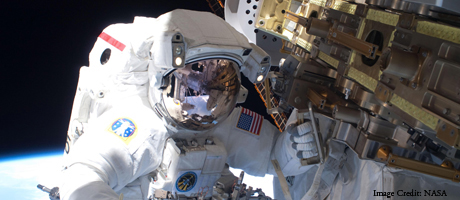By Menachem Wecker
President Barack Obama delivered a speech this afternoon at the Kennedy Space Center on Merritt Island, Fla., outlining what the White House Office of Science and Technology Policy describes as “a bold strategy for human spaceflight.”
According to the White House, the president’s plan, which will increases NASA’s budget by $6 billion over the next five years, will “jumpstart” a new commercial space transportation industry and will begin work on a “heavy-lift” rocket that can go farther into space.
Critics say the plan, which is a departure from the previous administration’s emphasis on a return to the moon, retires the space shuttle and will require the United States to hitch low-Earth orbit rides -- up to 2,000 kilometers above the earth’s surface -- with other countries while it waits for private companies to develop the necessary technology to access the International Space Station.
Among other things, the White House states that the president will promote a “scaled-down variant” of Constellation, a human space flight program launched under the Bush administration. Both the president’s plan and Constellation stress the importance of sending astronauts to Mars.
According to John Logsdon, professor emeritus of political science and international affairs, the Obama administration had announced the cancelation of Constellation when it presented its budget on Feb. 1 in order to take “a different approach to human space flight.”
“Since Feb. 1, there’s been no involvement from the president saying, ‘This is my vision for the future in space. Here’s what I think our goals should be. Here are the reasons we should be making these changes,’” says Dr. Logsdon. “That’s what happened today.”
According to Dr. Logsdon, the White House’s revelation that President Obama will restore “one element of the Constellation program in a diminished form,” the Orion crew capsule, comes as a surprise, as is the president’s decision to set a deadline of 2015 for NASA to choose which rocket it will build to take people beyond earth’s orbit.
Canceling Constellation is controversial, and it has pitted astronauts Neil Armstrong, who thinks the program must continue, against Buzz Aldrin, who supports the White House’s decision to end it. “A lot of the old timers say we should be doing it the way we did it back during Apollo,” says Dr. Logsdon. “This new approach is explicitly saying the time of Apollo is over. I think it’s time to move on.”
According to Dr. Logsdon, there is a “pretty deep split” about “the wisdom of what the president is proposing” in the space policy community. But there is a clear irony in how the issue is dividing Democrats and Republicans in Congress. While the Democratic president is proposing less government involvement in space and an increased role for the private sector, Republicans are pushing for the continuation of a federal program. The Republicans’ position makes more sense, Dr. Logsdon says, when one considers that many of the congressmen who are critical are from districts in Alabama, Texas and Florida where the Constellation program is located.
This lack of unified domestic support for the White House vision for space exploration makes it hard for the White House to address international cooperation and division of labor, says Dr. Logsdon.
“In the White House fact sheet there is no word at all about international participation, and I was hoping -- and still hope -- that the president says to his fellow heads of state that we want your countries to work with the United States in doing this,” says Dr. Logsdon.
Scott Pace, director of GW’s Space Policy Institute, disagrees. According to Dr. Pace, the White House plan for space exploration, though it has many good elements, seems to respond to criticisms by specific congressional interests, like preserving Constellation jobs, rather than presenting a “coherent architectural approach to human exploration beyond low Earth orbit.”
“I’m pleased that the president is continuing to talk about human exploration beyond low Earth orbit,” says Dr. Pace. “And I’m pleased he recognized the need for a heavy-lift vehicle to support exploration and the need to ensure U.S. crews have more options for returning from the International Space Station.”
But the White House’s budget for NASA, although in-line with past growth projections from previous administrations, focuses on research and development of the new rocket at the expense of “a lower overall percentage of the NASA budget going to human space exploration than in the past.”
“While the administration’s intentions for getting to low Earth orbit -- relying on commercial launch vehicles -- are clear, how human exploration is to be conducted beyond low Earth orbit is not,” says Dr. Pace. “The previous Constellation program had a defined path for transitioning from the shuttle to new vehicles that could support missions to the moon and Mars, along with commercial sources to Earth orbit as they proved themselves. However, there is no such clear path as yet today.”


